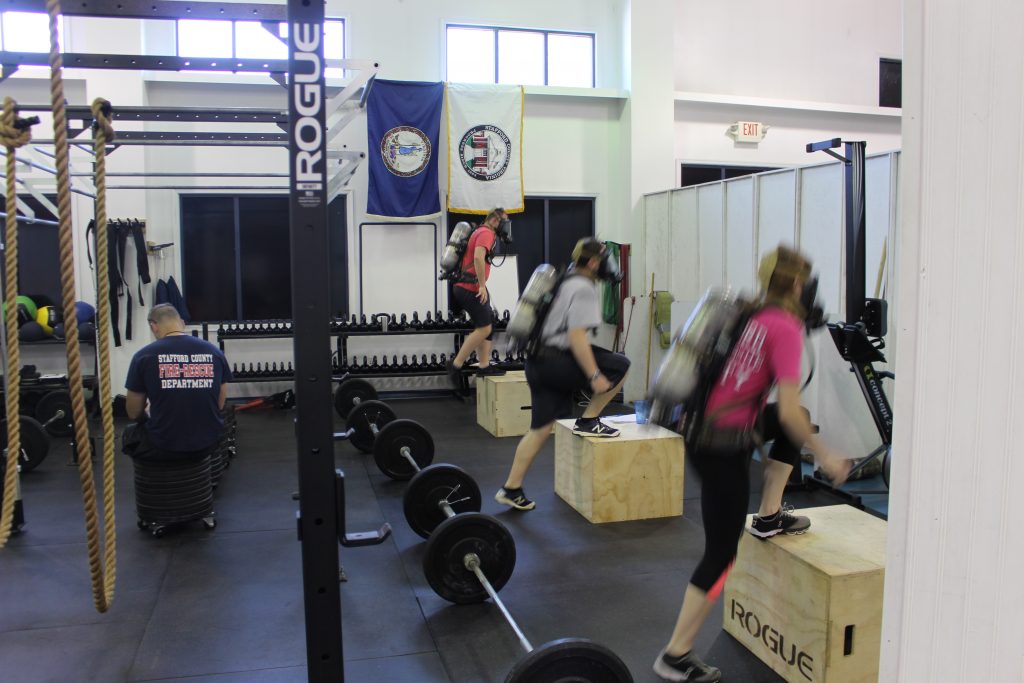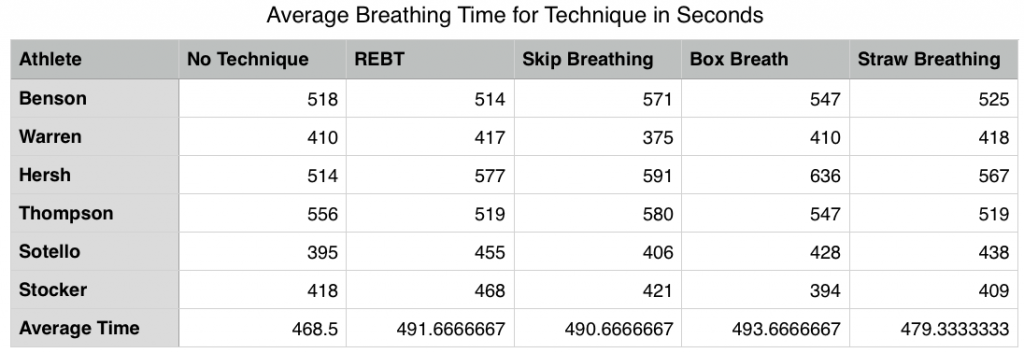
By Brice Long
We set out to take a closer look at some techniques aimed to extend the operating time of a firefighting self-contained breathing apparatus (SCBA) cylinder – particularly in an emergency situation. Here is what we found, what we didn’t, and what we learned along the way.
Background
No matter how advanced a firefighting breathing apparatus, operational time is still limited by the user’s capacity for air consumption. Under normal conditions, this means working longer and getting more accomplished before needing to rehab, but in an emergency, each additional breath can equal precious seconds for rescue or escape.
Using a simple physical assessment, detailed below, we tested four techniques and a control. Our intention was to identify an effective and practical method of slowing the consumption of an SCBA air cylinder.
Study design
Test subjects: Six full-time firefighters, 5 male and one female
Uniform: PT clothing and athletic footwear
Course/event:
The participants began the test wearing an SCBA with 1,000psi of air.
When the “go” command was given, athletes attached their regulators and began the test.
Set to a 30bpm metronome, the procedure was:
- 15 step ups onto a 20” box
- Turn and address a barbell
- 5x, 95/135# deadlifts
- Turn back and address the box
- The participants completed this cycle until the SCBA low air alarm stopped.
They then stopped working and continued the breathing technique until the cylinder was completely empty.
A 20-minute recovery was given before the test was repeated with the next technique
Trials:
- (1) Control: No specific technique. Participants were instructed to try to breathe slowly and conserve air, but not use one of the listed procedures.
- (2) Skip breathing – A normal inhalation held for several seconds, followed by an additional inhalation before exhalation
- (3) Box breathing – A slow inhalation over 3-4 seconds, held for 3-4 seconds, exhaled over 3-4 seconds, and then held for 3-4 seconds before the next inhalation
- (4) The Reilly Emergency Breathing Technique (R-EBT) – A slow inhalation followed by an exhalation that was controlled by the athlete making a humming sound as the breath was released
- (5) Straw breathing – A slow inhalation followed by an exhalation that was controlled by pursing the lips to mimic breathing through a straw
Data collection
Each effort was timed from the beginning of the test until the athletes’ air supplies were completely exhausted. All participants began each evolution at the same time and would raise their hands when they could no longer breathe through their SCBA regulators, their time was then stopped. At the conclusion of each test, the participants were given a brief survey and asked to rank the technique (1-10, bad-good scale) for comfort, ease of implementation, and practicality. They also answered “Would you implement this technique in an emergency?” with a yes or no and commented subjectively on the technique. Average and maximum heart rate were monitored, but that data was found to be unremarkable.
Results
Our goal was to identify a best practice breathing technique for emergency situations – one method recommended to make a cylinder last longer when it counts. That method would be determined through testing to be both effective and sustainable. Sustainability is key. For instance, if an athlete could just hold his or her breath for 4 minutes after each inspiration that would really extend a cylinder, right? Of course, but that’s not a practical solution. Our one golden bullet breathing technique would need to be both user-friendly and functional.
However, what we found wasn’t one across-the-board best practice, but success in a number of techniques depending on each athlete’s response to it. It was clear that the use of a breathing technique was better than not, but beyond that, there was not a consistent trend to distinguish either the REBT, skip breathing, or box breathing as the clear winner.

The sustainability piece seemed to be a highly individualized variable within the test. One athlete found the REBT very comfortable and maintainable, while another found it made him lightheaded and he was unable to maintain it. Even more interesting was the varied relationship between the level of comfort and effectiveness. Some athletes found X technique the easiest to maintain but had poor results with it. Others found technique Y impossible, though it did extend the life of the cylinder. Further, there was not one common technique in which all athletes found a high level of success and comfortability.

Although the answer to our initial question wasn’t as clear-cut as we’d hoped (do X technique because it’s the best), we were able to identify a possible best practice for extending the operating time of an SCBA cylinder in an emergency situation.
(1) We identified three effective techniques that were consistently successful in lengthening the operating time of an SCBA cylinder during consistent moderate work
(2) Preference and success among the three techniques were highly individualized among the participants
(3) The best technique will be the one each firefighter finds to most closely fit within his or her comfort zone and with which he or she trains regularly

Discussion
It’s important to understand, at least at the most basic level, what we are trying to accomplish with these SCBA breathing techniques. Our aim should be to determine the best method of narrowing the gap between air required and air consumed for a given amount of work. Each athlete has a minimum amount of air he or she needs at a certain level of exertion, but normal breathing is highly inefficient and the air consumed with each inhalation greatly exceeds the amount required. We exhale a lot of unused oxygen in each breath. In normal life, this isn’t a huge deal, but when we’re limited to a finite amount of air carried in a backpack…different story.
The most effective technique may be different for each person and is the one that forces the athlete to breathe with the greatest efficiency. Further, the best practice will be the one that balances this efficiency with the athlete’s ability to tolerate it. So a technique that is sustainable, but that also forces the athlete to only take in a minimally effective dose of air. Comfort is relative here as a good technique will not feel like normal work of breathing, but one that pushes the athlete to the brink of passing out probably isn’t the best either.
Like anything within the MTI AOR, simply identifying an effective option is but the beginning. The most reliable service weapon, the lightest pair of crampons or most comfortable plate carrier are each worthless to athletes until adequate time has been spent training with each. The trial run for a new piece of kit, no matter how “latest-and-greatest” it is promised to be, should never be when it counts. These breathing techniques are no exception to that rule.
Action items/moving forward:
- Test each technique and identify which is the best fit (most effective, yet sustainable) for you.
- Try the test we used with a couple of techniques. Find the technique that makes your cylinder last the longest and that you feel could be replicated under stressful conditions.
- Train that technique until you can’t do it wrong.
- Once you’ve found one, put it through the paces. Build time to practice the technique into your regular training. A drill for this might look like: an EMOM effort of 20 kettlebell swings, 20 step-ups, or 40’ shuttles utilizing the breathing technique. Complete the effort until the air cylinder runs out. To take it a step further (and add some stress) make the drill into a competition at the firehouse and see who can last the longest.
- Report back with your successes and challenges
- After you give the techniques a try, find the right on for you, and practice it – let us know how it’s going. The more lab rats in the game, the better.
- After you give the techniques a try, find the right on for you, and practice it – let us know how it’s going. The more lab rats in the game, the better.
Questions, Comments, Feedback? Email coach@mtntactical.com
About the Author
Brice Long is a career firefighter in northern Virginia and a Certified Strength and Conditioning Specialist (CSCS) through the National Strength and Conditioning Association.
He is currently assigned to the training division where he works at the academy and is responsible for managing strength and conditioning programs for the recruits and firefighters in the field. Brice graduated from Roanoke College in 2009.
You Might Also Like MTI’s Wildland Firefighter Endurance Assessment
